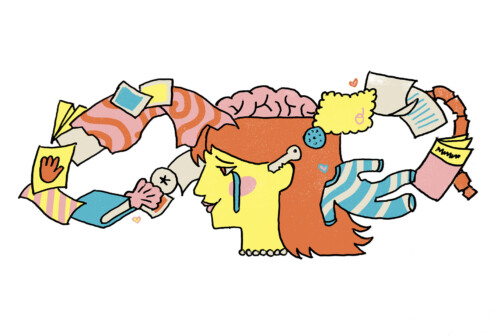A YEAR AGO, I believed that transportation was the top issue facing Dallas in the Eighties. It’s still a matter of major importance, but, with any luck, voters will approve the Dallas Area Rapid Transit (DART) program on August 13 and that problem will be on its way toward a solution. Perhaps then we’ll have the time, political energy and moral fortitude to deal with our most disturbing dilemma: public education.
It is a headache that’s psychosomatic in nature, overlaid with guilt and undergird-ed by the need to atone. Its origins can be traced back to Brown vs. Board of Education in 1954. The terrible irony of that Supreme Court decision is that it promised minorities access to education, with the expectation that access to economic and professional success would follow. But with the Burger court’s busing edict in the Swann vs. Charlotte-Mecklenberg case of 1971, precisely the opposite was delivered. In response to Richard Nixon’s “strict constructionist” court (another terrible irony), our schools lowered their standards, discarded traditional concepts of learning that had assimilated countless immigrant children into American life, and served, instead, a course offering of phony electives.
The promise of the courts became a cruel hoax as minority students were socially promoted up, out and into the world with barely the ability to read and write, let alone compute. White families fled to the suburbs, and separate but equal became the norm once again. Consider the Conner Elementary School in East Dallas: Even today, the student body is 80 percent white from kindergarten through the third grade. But busing starts in the fourth grade, so at that level Conner becomes 70 percent black. Is this what the Burger Court hoped to accomplish?
A Minority Neighborhood Option Plan for Dallas schools is currently before the 5th U.S. Circuit Court of Appeals. This proposal would permit students, if they chose, to attend the school nearest their homes and not be bused across town. Undoubtedly, the crowded facilities in South and East Oak Cliff would have to be renovated. New schools would have to be constructed. But the plan is definitely worth a try and is well worth the cost of implementation.
Of course, the courts can achieve nothing if educators don’t return to their true calling. Every student has a right to study English, math, science, history and a foreign language. Inevitably, some students will do better than others, but that’s no excuse for not trying to teach them all. Already there are steps in the right direction in the DISD. Individualized instruction-the rage of the Sixties and Seventies that left children grappling alone with learning kits -is giving way again to classes that work together from the same book, guided as a group by the teacher. If class size could be limited to 15 students for each teacher, who knows what gains could be made?
While a number of innovations in education have been disastrous, some recent moves clearly have made sense. The Dallas Institute for Humanities and Culture has been engaged to develop a curriculum for the Humanities-Communications Magnet. These are no-nonsense people like Gail Thomas, Don and Louise Cowan and Robert Sardello, who were long associated with the University of Dallas and who know what it is to build an institution that delivers on its promises. The Dallas Institute is also seeking a grant to start a special program for high school literature teachers that would intensify their learning and teaching experience.
This summer, nearly 80 carefully selected DISD students participated in an academic camp at the Greenhill School, pursuing math, science, language arts, writing and vocabulary. Funded by Exxon, Sun Oil Exploration and the Zale Foundation and taught by Greenhill and DISD faculty, this camp represented the kind of effort that can flourish outside the bureaucracy when a few committed people (in this case, Dr. Juan Flores of the DISD and Phillip Foote of Greenhill) get behind it.
Project Seed is another example of using talented outsiders to circumvent the teacher unions and help solve a critical problem facing the district: the shortage of math teachers. Drawing on mathematicians from outside the DISD, this program operates on a contract basis. Its performance has been impressive, but Project Seed, like the others, is only part of the answer. There is still no workable substitute for principals who lead and teachers who teach.
The Dallas Chamber of Commerce has recently endorsed a plan to provide federal scholarships for teachers who are currently teaching in other fields to return to college and study math or science. The program also would offer college loans to students who would train to become math or science teachers. Interest payments on these loans would be cancelled upon graduation, and the principal amount would be reduced by 20 percent for each year that the person teaches. This idea makes a lot of sense, and it could be extended to English, history and foreign languages as well. If a certain Peace Corps cachet could become attached to teaching, it might lure the sons and daughters of the middle class back into the profession.
At the Constitutional Convention during the sultry summer of 1787 in Philadelphia, James Madison noted that GeorgeWashington and Benjamin Franklin “laidtheir shoulders to the great points, knowing that the little ones would follow ofthemselves.” Teachers, principals and curriculum are the great issues of publiceducation today. It’s not hard to see what’sneeded: a graceful withdrawal by thecourts; an infusion of funds for teachertraining and salaries (merit pay or master-teacher plan); the determination to eliminate extraneous subjects and focus on theessentials; the will to raise our standardsand stick to them; and the conviction thatexcellence is possible.
Get our weekly recap
Brings new meaning to the phrase Sunday Funday. No spam, ever.
Related Articles

Local News
Bill Hutchinson Pleads Guilty to Misdemeanor Sex Crime
The Dallas real estate fun-guy will serve time under home confinement and have to register as a sex offender.
By Tim Rogers

Restaurants & Bars
The Best Japanese Restaurants in Dallas
The quality and availability of Japanese cuisine in Dallas-Fort Worth has come a long way since the 1990s.
By Nataly Keomoungkhoun and Brian Reinhart

Home & Garden
One Editor’s Musings on Love and Letting Go (Of Stuff, That Is)
Memories are fickle. Stuff is forever. Space is limited.
By Jessica Otte


